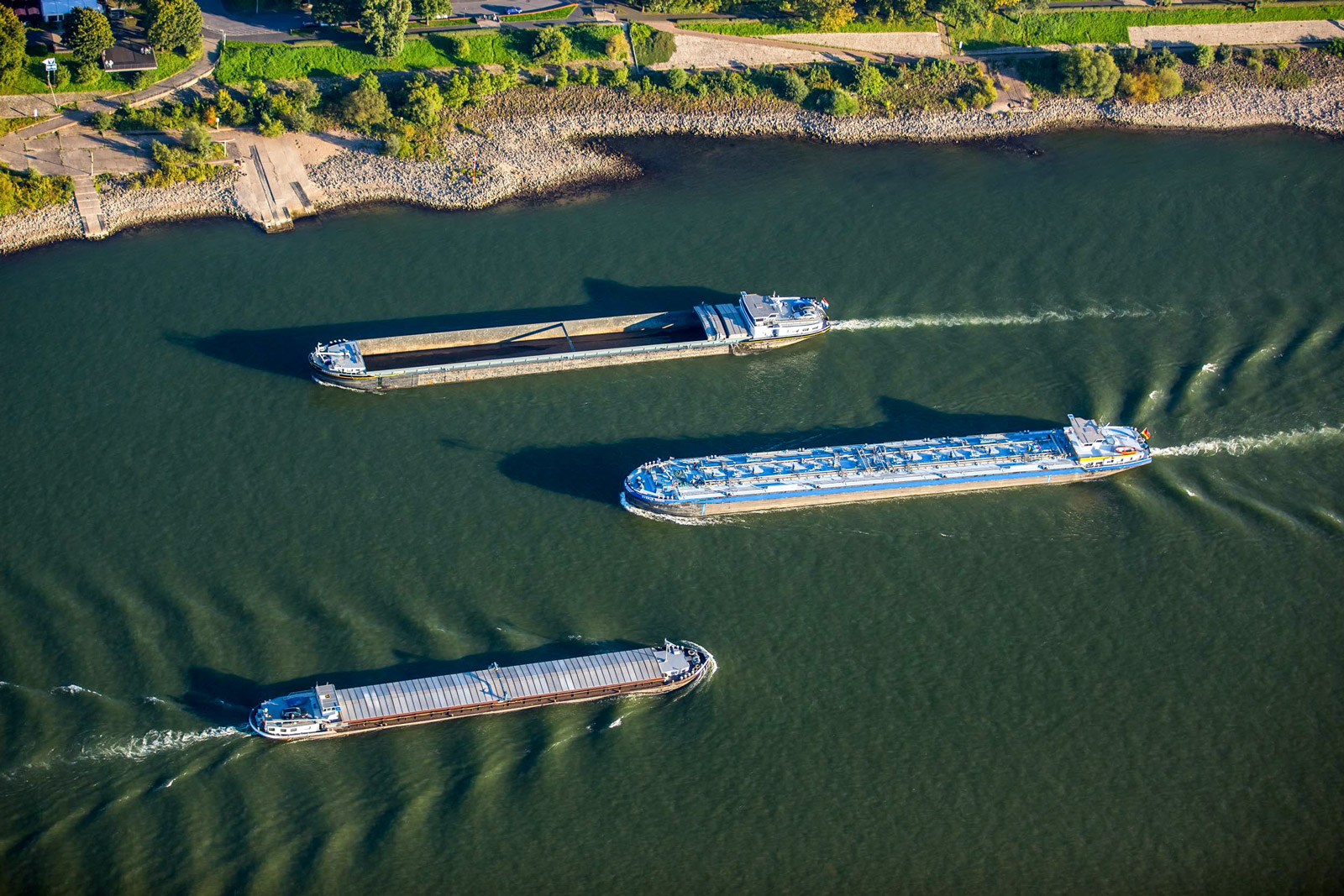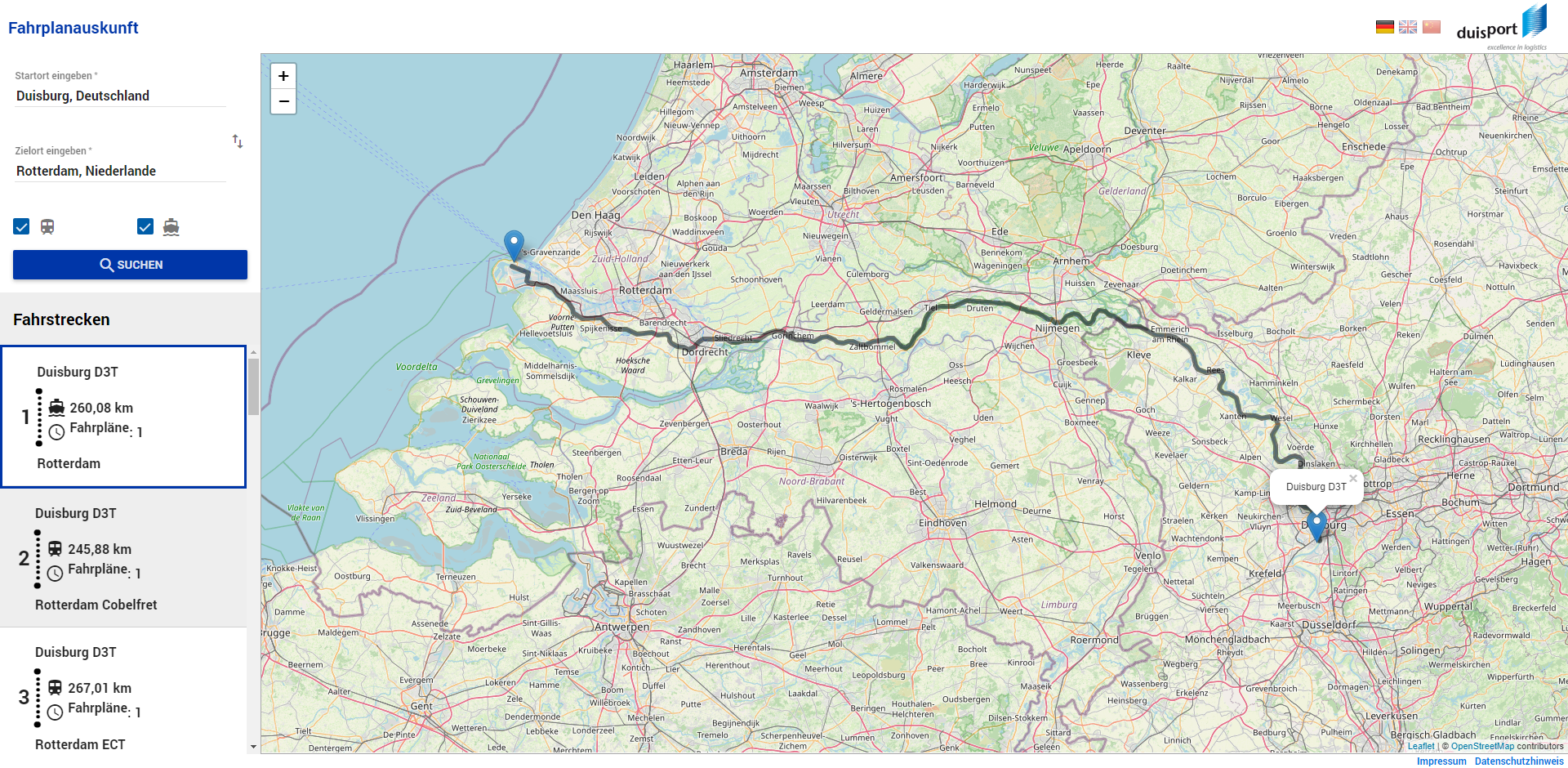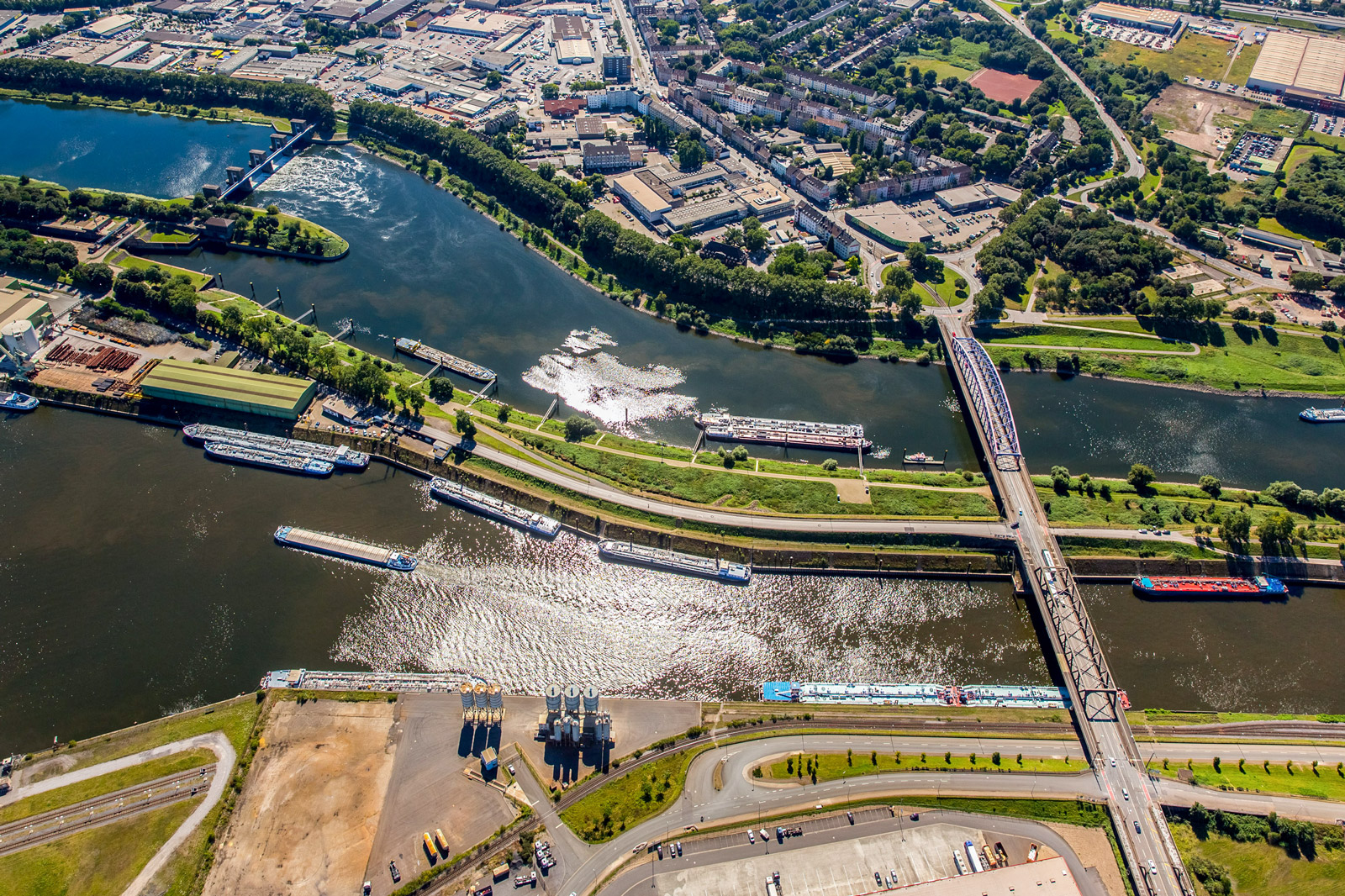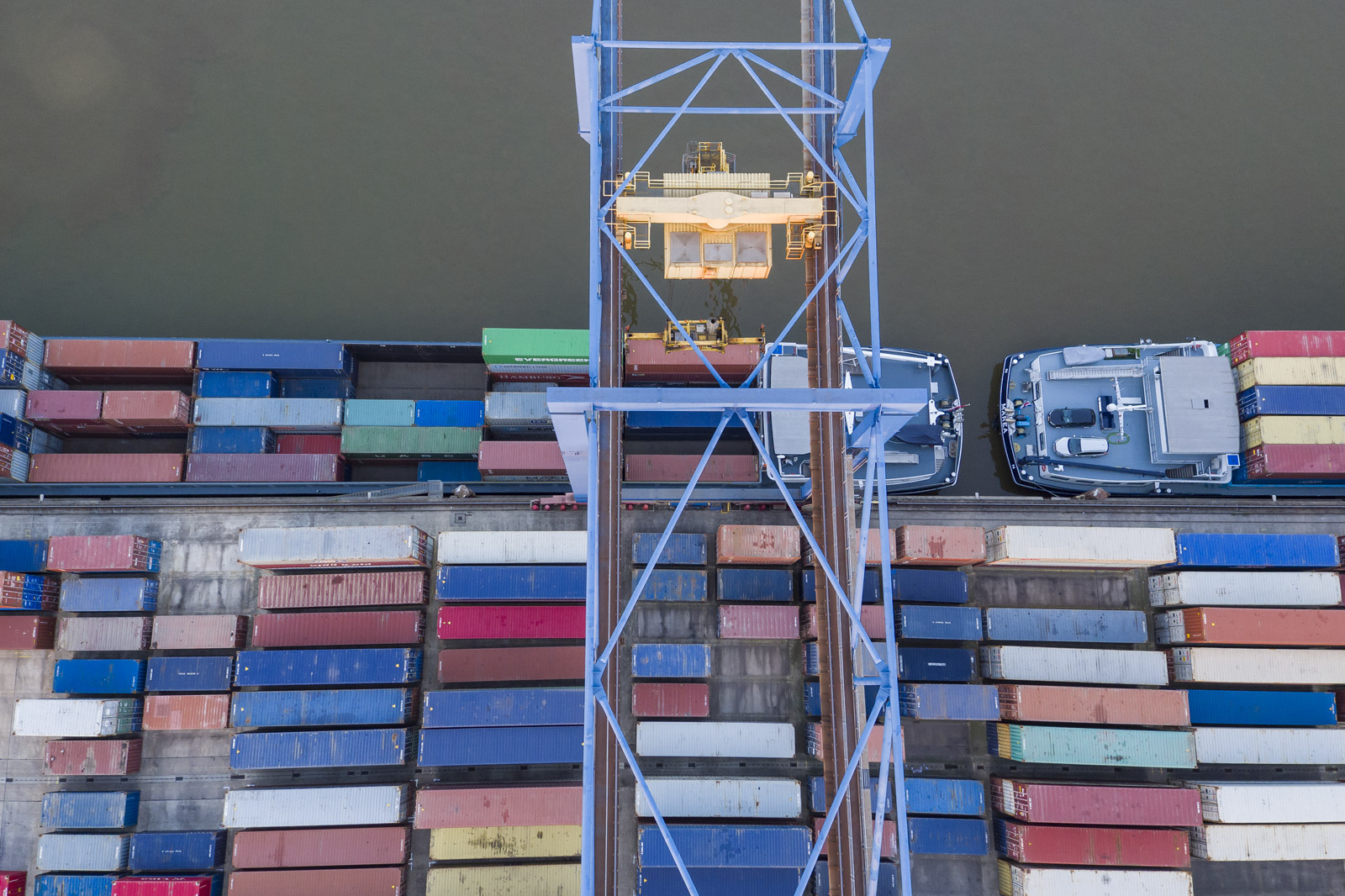
All general information about the mooring, such as current consumption, household waste disposal, ship waste reception and handling plans, and drinking water delivery can be found here.
Inland waterway transport and short sea shipping
We have collected all important information on inland waterway transport and short sea shipping on this page.
Included in this is general information about the mooring, such as current consumption, household waste disposal, ship waste reception and handling plan and drinking water delivery.
Furthermore you will also find here all nautical information about the harbor bottom and loaded drafts, bridge passages, clearance of the handling halls protruding over the water and the regulations for traffic of pusher trains and coupled vehicles.
General Information
-
Current consumption
-
The shore power fueling stations are located by / near the water level station. At these sites, vessels can be connected to the charging station with the CEE plug, and the charging process can be started and ended using the eCharge+ app. Payments can be made by credit card or PayPal. Billing is based on the amount of energy consumed (kWh), which is displayed in the app.
-
Household waste disposal
-
The disposal of common household waste is free. Commercial waste is calculated accordingly.
Garbage bags can be requested at Hafag 38 under 0160-5309715.
-
Ship waste reception and handling plan
-
Download the current ship waste reception and handling plan here.
-
Drinking water
-
Available from the port master in the water level station. Drinking water for freight ships is integrated into the port fee. Thus every freight ship that navigates the mouth of the harbor to load drinking water is also liable for demurrage charge.
Please note that the normal household quantity of drinking water is issued.
Passenger ships are excluded from delivery of drinking water.
-
Harbor master
-
The port master in the water level station is available for questions Mo-Fr from 6:00 am - 11:00 pm and Sat from 07:30 am -12:30 pm.
Radio: UKW 14
Telephone: +49 (0)203 803 - 4257
Fax: +49 (0)203 578989 456
Email: anmeldung@duisport.de
fahrgastschiff@duisport.de
The water level station is only occupied by the duty alarm and alert outside of the times mentioned above. During this time no information on berths, invoices or accounts can be given. Also cash payment of the berth fees or the purchase of electrolyte bridges is not possible.
Nautical Information
Harbor floor and loaded draft
The present valid target harbor floors and water level gage zero points can be seen in the center column of the table below.
The draft should be at least 30cm lower than the respective water depth (float water). Taking into consideration this regulation and the level differences, so called approximate values result in the right column, which are only based on the Ruhrort level. In borderline cases the permissible loading draft based on the target bottom values, the respective water level on the Ruhrort level and the level of safety (at least 30 cm) must be precisely calculated.
The target bottom values indicate the minimum depth, which with sloping shorelines, however, is not available on the entire water area:
| Port basin | Target bottom or gage zero point above sea level | Loaded draft (approximate value) |
|---|---|---|
| a) Ruhrort gage zero point | 16.09 m | Respective water level at Ruhrort level |
| Mouth of port, Vincke canal, south port, Ruhrort, port canal, | 15.40 m | + 40 cm |
| Bunkerhafen, Basin A, Basin B, Basin C | 15.90 m | |
| Boatyard harbor | 17.05 m | - 120 cm |
| b) Duisburg | ||
| Parallel port, outer harbor | 16.10 m | + 40 cm |
| c) Hochfeld | ||
| South and Kultus harbor | 16.45 m | + 40 cm |
| d) Rheinhausen | ||
| Port of Rheinhausen | 16.50 m | *download Rheinhausen bottleneck fact sheet |
| e) Meiderich canal port, Neuenkamp Ruhr port | acc. to BinSchStrO, exception Wendehafen = 280cm |
Bridge passages
The overview below contains, among other things, reference values for calculating the passage height. They are based on the Ruhrort level and take into account the level difference and a safety margin.
In borderline cases the outermost passage height must be determined with the aid of the indicated N.N. values and the respective water level on the Ruhrort or Duisburg level. They can also be read from the reverse water gage attached to the bridge abutments.
| Bridge | Lowest point of the foundation or gage zero point above sea level. | Reference value for calculating the passage height* |
|---|---|---|
| a) Ruhrort gage zero point | 16.09 m | |
| Bridge over the mouth of the harbor | 34.20 m | 17.80 m |
| Vincke canal bridge | 33.10 m | 17.05 m |
| Harbor canal bridge | 33.80 m | 17.40 m |
| Bridge over Basin C | 38.20 m | 21.80 m |
| b) Duisburg | ||
| Pipeline bridge over the outer harbor | 37.80 m | 20.90 m |
| Street bridge over the outer harbor | 37.00 m | 20.90 m |
| c) Rheinhausen | ||
| Power bridge | 38.00 m | 20.75 m |
for calculating the passage height!
Clearance height of the handling halls protruding over the water
The overview below includes reference values for the calculation of the passage heights of the handling halls protruding over the water. The respective water level on the Ruhrort water gage must be subtracted from the indicated values.
| South harbor halls, north side km 2.6 and 2.9 | 17.68 m |
| Harbor canal hall, south side km 2.85 | 17.50 m |
| Basin C hall, south side km 4.4 | 17.70 m |
| Basin C hall, north side km 4.0 | 19.14 m |
| Parallel harbor hall, south side km 0.6 | 19.20 m |
| Parallel harbor hall, south side km 1.3 | 20.40 m |
| Outer harbor hall, north side km 0.4 | 18.00 m |
| Outer harbor hall, south side km 1.45 | 26.10 m |
| Parallel harbor hall, north side km 0.5 | 17.00 m |
| Parallel harbor hall, north side km 0.7 | 19.60 m |
| Vincke canal hall turning area | 20.30 m |
Traffic from pusher trains and coupled vehicles
- Vessels and tow barge combinations must be transported, assembled and disconnected in such a way that the safety and proper operation of the port and port facilities, along with the environment, are not negatively influenced, and that nothing else is damaged or put at risk, or hindered or inconvenienced more than is inevitable under the circumstances.
- The length, width, height, draft and speed of vessels and tow barge combinations must be adapted to the conditions of the port waters and port facilities.
- In the case of imminent danger, ship captains must take all measures required under the circumstances, even if this forces them to deviate from the statutory provisions.
- Vessels and tow barge combinations may not pass other vessels – except small vessels.
- Small vessels may only be passed as an exception, once the passing unit has ensured that this maneuver can be completed without risk.
- Single small moving vessels, as well as tow barge combinations and connected vessels that consist solely of small vessels, must leave the space that is required by all other vessels to continue on their route and for maneuvering purposes.
- Vessel combinations and vessels should avoid encounters in tight waters that do not allow sufficient room for passing maneuvers. To this end, narrow passages must be traversed as quickly as possible. In the case of restricted view, all vessels and tow barge combinations must emit a "long sound" before they enter a narrow waterway. This sound must be repeated during the passage if the narrow waterway is of some length.
- If encounters are nevertheless impossible to avoid, the captain of the vessel combination must take all measures to ensure that the encounter takes place at a location and under conditions that rule out possible risks. If necessary, he must stop at a suitable location in a timely manner and provide as much space on the waterway as possible.
Ship list
More than 20,000 ships are processed annually by the port of Duisburg.
The water depth is optimally suited for river-sea ships with a load of up to 6000 tons. That corresponds to approx. 500 twenty-foot standard containers.
Here you will find an overview of the ship connections from the port of Duisburg. Included are line connections (container inland waterway ship traffic & ocean traffic) as well as tramp/project cargo in ocean and inland waterway traffic.
If you would like more information, please contact us directly.
Set your perfect route now!
Get direct access to the largest hinterland network to/from Duisburg and use our dynamic route planner. As a planner for combined transport, train and barge services are automatically combined.
Direct booking requests via the B2B booking platform are possible.
To do so, simply click on our route planner below (route planner opens automatically within a new tab).

Port fee
The port fee deviates on the following listed holidays for a stay of one to three calendar days:
- Easter from 28.03.2024 (thursday), 6:00 pm until 02.04.2024 (tuesday), 8.00 am
- Whitsun from 17.05.2024 (friday), 6:00 pm until 21.05.2024 (tuesday), 8.00 am
- Christmas from 22.12.2024 (sunday), 6.00 pm until 27.12.2024 (friday), 8.00 am
- Silvester from 30.12.2024 (monday), 6.00 pm until 02.01.2025 (thursday), 8.00 am
These rules apply exclusively to motor cargo ships without turnover cargo.
The current Fee overview for port and pierage 2023 is available for download here.
The new Fee overview for port and pierage valid from 2023 is available here:

Port fee calculator
The port fee is a requirement which is due for the use of the port and its facilities or equipment. The port fee is to be paid by the owner of a vessel or a floating installation.

Pierage
Pierage is to be paid for all cargo that is handled over the shoreline from ship to ship or loaded using port equipment. Pierage must be paid from companies settled in the port who carry out turnover cargo.